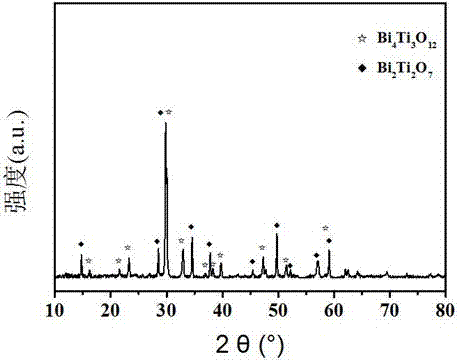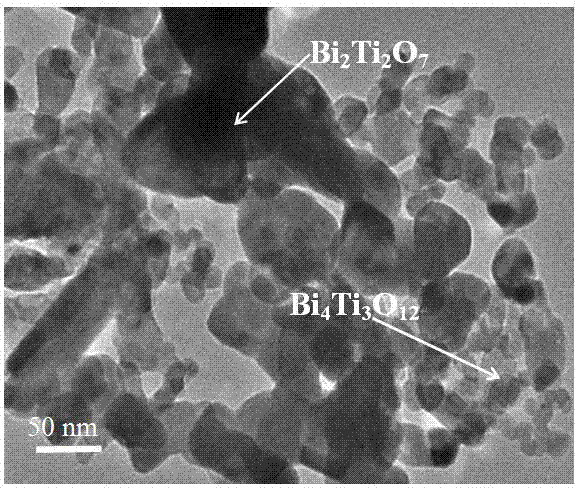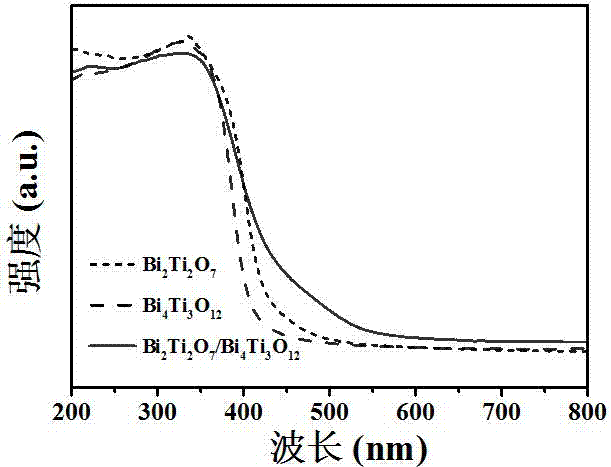Bi2Ti2O7/Bi4Ti3O12 composite photocatalyst and preparation method thereof
A catalyst and composite light technology, applied in the field of photocatalysis, can solve the problems of large particles of bismuth titanate-based mixed crystal material, high photo-generated electron-hole recombination rate, and difficulty in efficient utilization of visible light, etc. High absorption capacity, beneficial to industrial application
- Summary
- Abstract
- Description
- Claims
- Application Information
AI Technical Summary
Problems solved by technology
Method used
Image
Examples
Embodiment 1
[0024] Add 20 mL of glacial acetic acid solution to a 50 mL beaker, then add 0.8 g of bismuth nitrate, stir until dissolved, add 0.5 mL of acetylacetone and 0.5 mL of tetrabutyl titanate with a micro-injector, and mix the reactants evenly Afterwards, the solution was poured into an evaporating dish and evaporated at 180 °C for 10 h. The obtained powder was placed in a crucible and calcined at 650 °C for 2 h.
[0025] figure 1 For the XRD diffraction pattern of the prepared sample, the diffraction peaks in the figure are Bi 2 Ti 2 o 7 or Bi 4 Ti 3 o 12 Compared with the standard JCPDS card (32-0118, 21-1272), the characteristic diffraction peak can be identified as Bi with good crystallinity 2 Ti 2 o 7 / Bi 4 Ti 3 o 12 Powder, figure 2 It is the transmission electron micrograph of the prepared composite photocatalyst, the larger particle in the figure is Bi 4 Ti 3 o 12 Particles, smaller particles are Bi 2 Ti 2 o 7 , it can be seen from the figure that Bi 2 ...
Embodiment 2
[0028] Add 20 mL of glacial acetic acid solution to a 50 mL beaker, then add 0.6 g of bismuth nitrate, stir until dissolved by magnetic force, add 0.5 mL of acetylacetone and 0.5 mL of tetrabutyl titanate with a micro-injector, and mix the reactants evenly Afterwards, the solution was poured into an evaporating dish and evaporated at 140°C for 5 h. The obtained powder was placed in a crucible and calcined at 550 °C for 0.5 h.
Embodiment 3
[0030] Add 20 mL of glacial acetic acid solution to a 50 mL beaker, then add 0.8 g of bismuth nitrate, stir until dissolved, add 0.5 mL of acetylacetone and 0.5 mL of tetrabutyl titanate with a micro-injector, and mix the reactants evenly Afterwards, the solution was poured into an evaporating dish and evaporated at 140°C for 5h. The obtained powder was placed in a crucible and calcined at 600 °C for 1 h.
PUM
| Property | Measurement | Unit |
|---|---|---|
| Diameter | aaaaa | aaaaa |
| Particle size | aaaaa | aaaaa |
Abstract
Description
Claims
Application Information
 Login to View More
Login to View More - R&D
- Intellectual Property
- Life Sciences
- Materials
- Tech Scout
- Unparalleled Data Quality
- Higher Quality Content
- 60% Fewer Hallucinations
Browse by: Latest US Patents, China's latest patents, Technical Efficacy Thesaurus, Application Domain, Technology Topic, Popular Technical Reports.
© 2025 PatSnap. All rights reserved.Legal|Privacy policy|Modern Slavery Act Transparency Statement|Sitemap|About US| Contact US: help@patsnap.com



